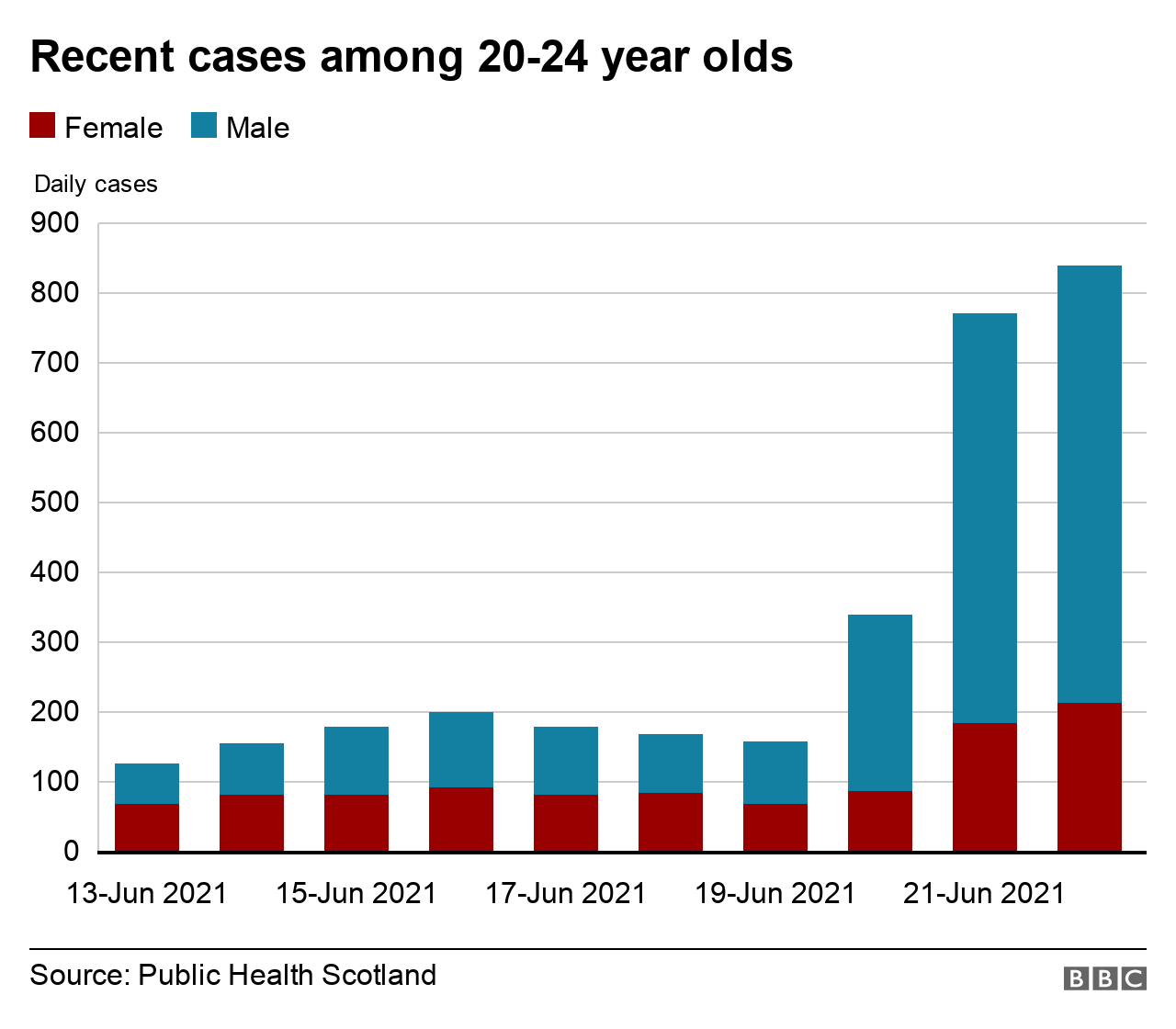Covid gender gap widens as cases surge in Scotland
- Published

Scotland fans travelled to London for last week's match against England while thousands more watched at home
A Covid cases gender gap has opened up as the total number testing positive in the past 24 hours hit nearly 3,000.
On Wednesday five new deaths were reported, and 2,969 cases recorded - the highest daily number since the start of mass testing.
In recent days about two thirds of cases in the 15 to 44 age range have been male.
Behaviour expert Prof Stephen Reicher has suggested that men meeting up to watch Euro 2020 is behind the rise.
National Clinical Director Prof Jason Leitch said he believed indoor socialising was the main factor, though not necessarily linked to football.
Public health expert Prof Linda Bauld said it was too early to link the spike in male cases to one particular activity - but she said the trend was "striking" and should be investigated further.
The figure for new cases, which in part reflects a high level of testing, is higher than the previous record from early January, at the height of the second wave.
A total of 42,310 people were tested in the previous 24 hours, the highest number carried out in Scotland in a single day, with 7.3% of tests coming back positive.
First Minister Nicola Sturgeon said the figures should be viewed in the context of increased testing and vaccination, but must also be taken seriously if the planned easing of restrictions is to go ahead.
In a series of tweets, she said about 5% of cases would end up in hospital - about half the proportion seen in January - but that could still put serious pressure on the NHS.
Allow X content?
This article contains content provided by X. We ask for your permission before anything is loaded, as they may be using cookies and other technologies. You may want to read X’s cookie policy, external and privacy policy, external before accepting. To view this content choose ‘accept and continue’.
Data from Public Health Scotland shows that throughout the pandemic as a whole there have been no dramatic differences between the sexes in infection rates, but this appears to have changed in recent days.
The following chart shows the total number of infections among 15 to 44 year olds since 1 May.

The current wave of Covid-19, linked to the Delta variant first identified in India, is spreading mainly among under 45s, with older age groups accounting for a relatively small number of new infections.
Among children under the age of 15, the gender balance in cases continues to be fairly even.
However, a widening gender gap is particularly evident in recent days among people aged between 20 and 24. In the latest figures, males made up more than three quarters of people testing positive in that age group.

Prof Leitch told BBC Radio Scotland's Drivetime with John Beattie programme he did not not believe football was directly to blame, but he did express concerns about large gatherings of football fans.
He said about a third of people recently infected had been in some type of hospitality venue, while another third had been in some kind of retail premises.
He explained: "As soon as you bring people together the virus moves."
Asked specifically about case rates among young men he said: "It's socialising. It's mainly indoor socialising, not outdoor socialising."
Prof Leitch said there would be patterns in behaviour over time, leading to "lumps and bumps along the way" and warned that dates given for further lockdown easing were dependent on people acting responsibly.
"The 19th of July and the 9th of August are not in pen in the calendar. They are in pencil in the calendar. They can be changed if the numbers don't continue to help us on the way and vaccination doesn't help us," he added.
Football 'obvious explanation'
Prof Reicher, an expert on behavioural psychology at the University of St Andrews and an adviser to both the Scottish and UK governments, believes indoor socialising linked to football is likely to be creating gender differences.
He told the BBC's Good Morning Scotland programme: "A few weeks ago it was about 50:50, men and women got infected at the same rate. Yesterday the data showed that young men - men under 45 - were about three times more likely to get infected.
"We can't be sure why that is, but the obvious explanation is that people were getting together for the football and not taking precautions."
Public health expert Prof Linda Bauld, from the University of Edinburgh, said she "would not rush" to blame the increase on any particular activity without more evidence, but suggested that males may be less averse to risky behaviour.
She said: "Males are more likely to takes risks and as the environment changes they may be more willing to engage in behaviours that maybe women are a little bit less likely to, or maybe a little bit more cautious - or maybe have fewer opportunities to.
"So we just don't know - but it looks like a trend to me and it definitely needs investigated."
Infection control expert Dr Christine Tait-Burkard, also of Edinburgh University, said it was possible that people planning to meet up to watch football were taking lateral flow tests as a precaution.
If they had a positive result, they would then seek a PCR test - and this would show up in the daily case number figures.

